
The sixth hole on the Black Course at Bethpage State Park, site of this month’s PGA Championship. The course, located on Long Island, was designed by A.W. Tillinghast and opened in 1936. The Black Course, host to the 2002 and 2009 U.S. Opens, will also be the host of the 2024 Ryder Cup. Photo by Gary Kellner/PGA of America
This was no ordinary birthday for Andrew Wilson.
On Sept. 17, 2013, Wilson walked into the clubhouse at Long Island’s Bethpage State Park in Farmingdale, N.Y. There were neither screams of “surprise” nor cake and ice cream awaiting him. He had no presents to unwrap, but Wilson was about to be gifted with the opportunity to help throw quite a party in the coming years.
Two of them, in fact.
Wilson, director of agronomy for the five golf courses on the property, was on hand along with New York Gov. Andrew Cuomo to hear PGA of America officials announce that Bethpage State Park’s Black Course would be the site of the 2019 PGA Championship and the 2024 Ryder Cup.
Happy birthday, Andrew!
“I knew something about the possibility of the PGA Championship, but the Ryder Cup was a little more of a surprise,” says Wilson, a 19-year GCSAA member. “I got to hold the Wanamaker Trophy (that goes to the PGA Championship winner) and touch the Ryder Cup. I told our (Black Course) superintendent, Michael Hadley, ‘We’ve got to get to work now.’”
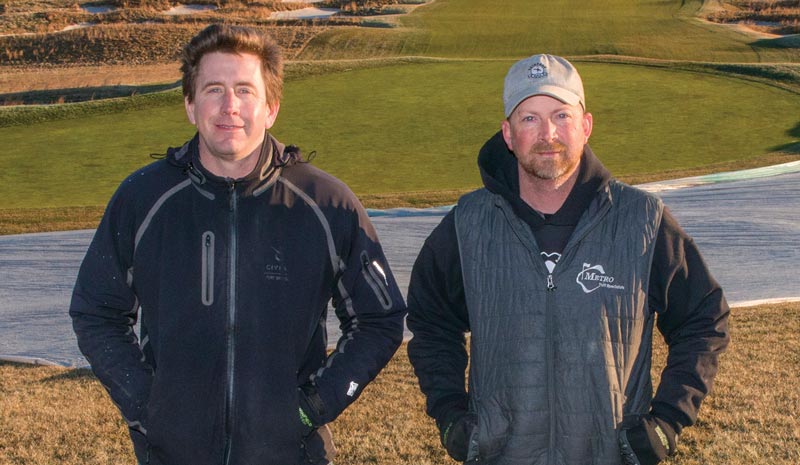
Bethpage State Park director of agronomy Andrew Wilson (left) and Black Course superintendent Michael Hadley provide veteran leadership as Bethpage prepares to host its first PGA Championship. Wilson has been a full-time employee since 1997; Hadley came aboard in 2000. Photo by Jim Krajicek
They didn’t know at the time that their work schedule would be accelerated — and it has historic implications and agronomic ramifications. On Aug. 8, 2017, the PGA of America announced that the PGA Championship would move from its usual spot on the calendar in August to May, which is no minor reconstruction in the major championship lineup.
The inaugural host site in the shuffle? Bethpage Black, May 16 to 19, 2019.
Obviously, this is going down in the spring, but Hadley, a 21-year GCSAA Class A member, has had it on his radar nonstop — for all four seasons. “You think about what is coming every day,” Hadley says. “During the summer. During the winter. Whenever. It keeps you energized.”
The PGA Championship: May or August?
A new day for the PGA Championship translates to a new way of preparing for an event of this magnitude at Bethpage Black. The Certified Audubon Cooperative Sanctuary was the site of the U.S. Open in 2002 and 2009, but those happened in June. The course also hosted The Barclays on the PGA Tour in 2012 and 2016, but those took place in August.
A phone call placed to Wilson three years ago by Kerry Haigh, PGA chief championship officer, helped launch a new era for the PGA Championship.
“He asked, ‘What’s the weather like in May?’ I believe he was looking at the pros and cons of August versus May,” says Wilson, noting that it can rain in May but hopefully not like it did 10 years ago when it disrupted the U.S. Open enough to force a Monday finish. The past two years, the weather the corresponding week in May has been favorable. Room temperatures (low 70s) for highs were mixed in with some 60s. “That’s a superintendent’s dream,” Wilson says. “In August, it could be 88 and sweltering. There’s almost no chance of that happening in May. Here, May is way better if you can get through the winter.”

Bethpage mower shop mechanics Adrano Maragh (left) and Rob Melito have been gearing up for a busy stretch that that will reach its pinnacle this month when Bethpage Black hosts its third major championship and its first since the 2009 U.S. Open. Photo by Jim Krajicek
A key reason why May is vastly preferable to August is simple: the management of Poa annua greens. “Poa is in its ascendency in May. It’s the peak time of the year. In August, it (Poa) basically is at its weakest point of the year,” says Wilson, who also has Poa/ryegrass fairways. “Over 90 percent of the time, that month we have huge stress, plus by August the golf course is getting a little tired.”
Here are some weather-related facts — including some positive news — for Haigh, who researched historic weather patterns at Bethpage Black: According to News 12 Long Island chief meteorologist Bill Korbel, the average high temperature the week of May 16-19 is 68 degrees, the average low is 50 (record-high temps range from 85 to 89, and record lows 37 to 40), and monthly rainfall is 3.78 inches. Bethpage Black is 8 miles from the Atlantic Ocean, and Korbel adds that May can mean cold water temperatures, which may create a substantial sea breeze that will drop temperatures and escalate winds by late afternoon.
“In general, May is a pretty benign month, and, from my experience playing golf on Long Island, the grass, trees, shrubs, and all matter of flowers and bushes are at their peak colors, and course conditions are usually lush and green. I suspect this year will be no different, because we had a very quiet winter with almost no snow and only two real cold snaps,” Korbel says.
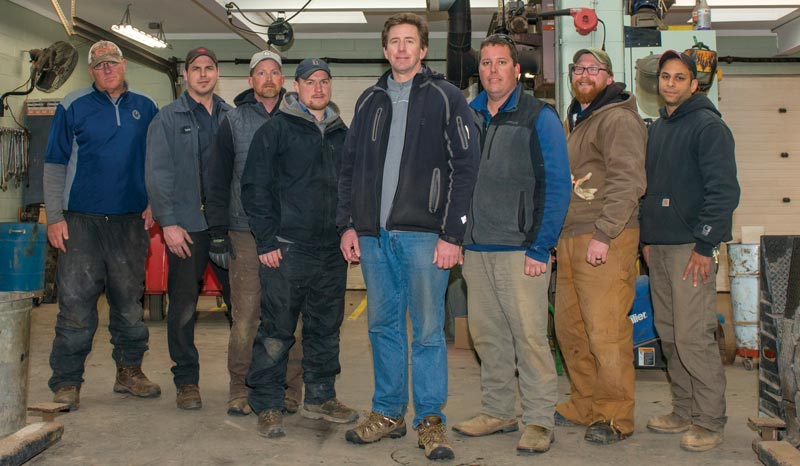
Those who oversee golf courses at Bethpage State Park, from left: Erik Feldman, Red Course superintendent; Sean Brownson, head mechanic; Michael Hadley, Black Course superintendent; Shawn Brownell, Blue Course superintendent; Andrew Wilson, director of agronomy; Vincent Herzog, construction superintendent; Eric Newell, Green Course superintendent; and Hamilton Lopes, Yellow Course superintendent. Photo by Jim Krajicek
It has been four years since winter damage affected greens at Bethpage Black. Before that, it was 2006. As many as five greens were hit hard in 2015, including No. 18. Greens were not covered as a precautionary measure this winter. “It can take until Memorial Day, into June, for greens to bed in again after that (winterkill),” Hadley says. “Sure, we’ve had years of winterkill where we couldn’t imagine having a PGA Championship in May, but nine out of 10 years, it’s going to be good.”
Hadley is hopeful that May will be, well, May.
“Grass really wants to grow in May, which is a good thing. You can be a little more aggressive in May as far as mowing heights and whatever you want to do to the greens. You haven’t had the wear and tear by May,” Hadley says, “and, leading up to it in April, you should be getting recovery with whatever you’re doing, whereas in August, you have to be more gentle, because you have to get through the season leading up to it. Being in May, hopefully we won’t have to drag hoses around at all for the tournament.”
The main concern in May, according to Hadley, is fescue, which depends on how wet or dry spring has been, and seedheads. “It’s a somewhat prime time for seedheads to come out, so hopefully our protection works well, and we time it right and stop the flush of seedheads and have dense, smooth Poa surfaces,” Hadley says.
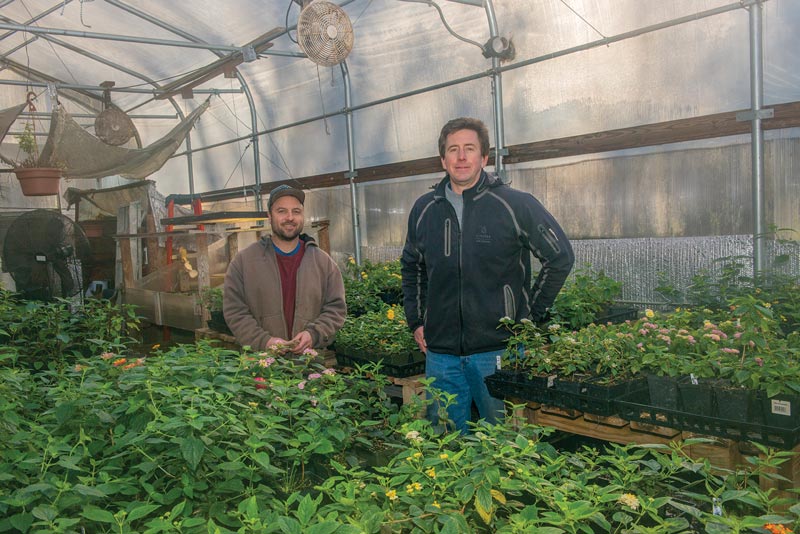
Andrew Wilson (right) with park horticulturist Victor Azzaretto. Photo by Jim Krajicek
A May major at Bethpage Black intrigues Cornell University’s Frank Rossi, Ph.D., who has worked extensively for several years with Bethpage golf courses. “You’ve got an island sticking out in the middle of the Atlantic Ocean. It’s a complicated time of the year,” says Rossi, recipient of GCSAA’s 2018 President’s Award for Environmental Stewardship. “(Conditions) are more predictable in August. What becomes the biggest issue (in May) is if the greens aren’t actively growing. Last May, when Michael did the run-through, he mowed them (greens) lower and altered the watering, and it was absolutely perfect — as perfect as it could be for that time of the year.”
Haigh likes his chances with Wilson and Hadley in charge. “Both of these gentlemen have had a lot of experience on the Black Course under championship conditions and know and understand its nuances better than anyone else,” Haigh says. “We anticipate the fairways, roughs and greens to be healthy and actively growing here in the springtime rather than has been the case with our previous August date, when we have been simply holding on to whatever health of cool-season grass we had.”
Practice rounds, maintenance-style
Bethpage Black was on trial the past two years. It passed the test both times.
Hadley staged practice runs in 2017 and 2018 leading up to May. He did not aerify at all in spring, but did increase rolling. By last fall, the staff was deep into preparations for the PGA Championship. Bethpage Black, the first public facility to host a U.S. Open (17 years ago), costs New York state residents $75 and non-state residents $150 to play on weekends. The course reduced rounds last fall and this spring, plus closed the back tees.
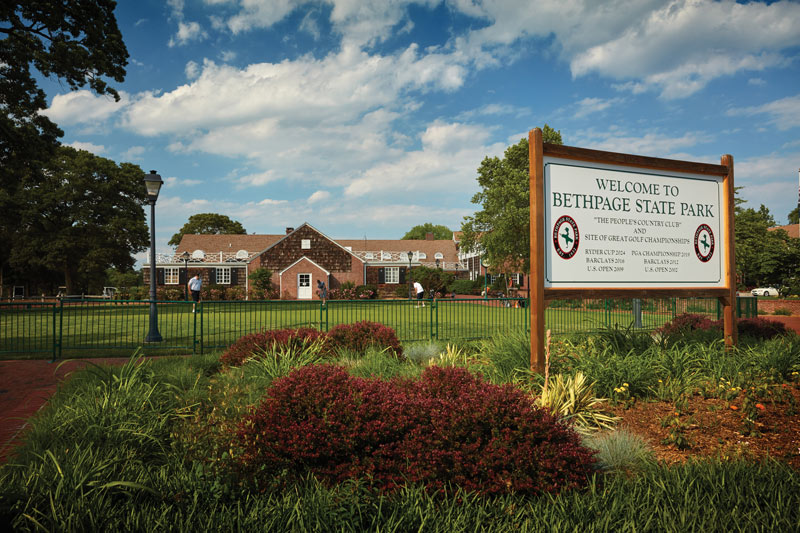
Located in Farmingdale, N.Y., Bethpage State Park’s Black Course was the first public course to host a U.S. Open when the event was contested there in 2002. More than 30,000 rounds are played annually at the Black Course, which is one of five courses at Bethpage. Photo courtesy of the PGA of America
“We didn’t do as much as we normally do last fall as far as aeration is concerned, to keep the surfaces firm and smooth,” Hadley says, “and we got our sand down, didn’t use covers, used more topdressing when we had a lot of good opportunities, and put out our dormant feeds. That’s why we felt good going into this spring. We got that out there, and it’s going to get some green-up from that. We also focused last fall on traffic areas. That was the good thing about the fall. We were able to sod what we needed to sod, but kept it as minimal as we could. Everything we did in the fall was to prepare to have a good spring. We feel good about what we did in the fall and preparing the turf and not suffering any catastrophic turf loss. Then, it was just waiting on spring to get things going. As Tom Petty said, ‘The waiting is the hardest part.’”
The bunkers were already in a good way, even before last fall. “We started years ago rebuilding the greenside bunkers (work on them was completed in early 2018, and 90 percent of it was done in-house). We knew this (PGA Championship) was coming up,” says Vincent Herzog, construction superintendent at Bethpage. “At the time, we didn’t know this would be in May, but still we didn’t want to have done anything that would stand out during the tournament. We wanted a whole growing season to make sure all of our projects were buttoned up.”
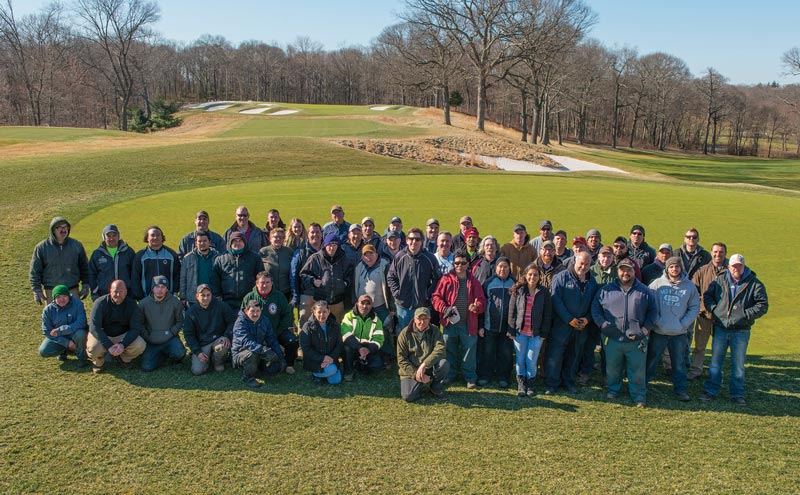
It takes a team — and the Black Course will have all hands on deck for the 2019 PGA Championship. Director of agronomy Andrew Wilson will welcome more than 100 volunteers for the event, including some traveling in from as far away as Slovenia and Australia. Photo by Jim Krajicek
The biggest challenge of a May event instead of an August one could be equipment. “It’s a bit more challenging because, just coming out of winter, the equipment hasn’t been tested much yet, and there’s only so much we can do at that time of the year,” says head mechanic Sean Brownson. “But I want things to run as smoothly as possible because of what this event means to Bethpage and to the PGA of America as it goes to a new date.”
Either way, May it is. So, come what may.
“May and August are like two different animals. Sometimes we don’t know what we’re going to get coming out of winter,” says Bethpage Black assistant superintendent Ryan Murphy. “What matters is seeing where we can take this place for a major championship.”
Howard Richman is GCM’s associate editor.